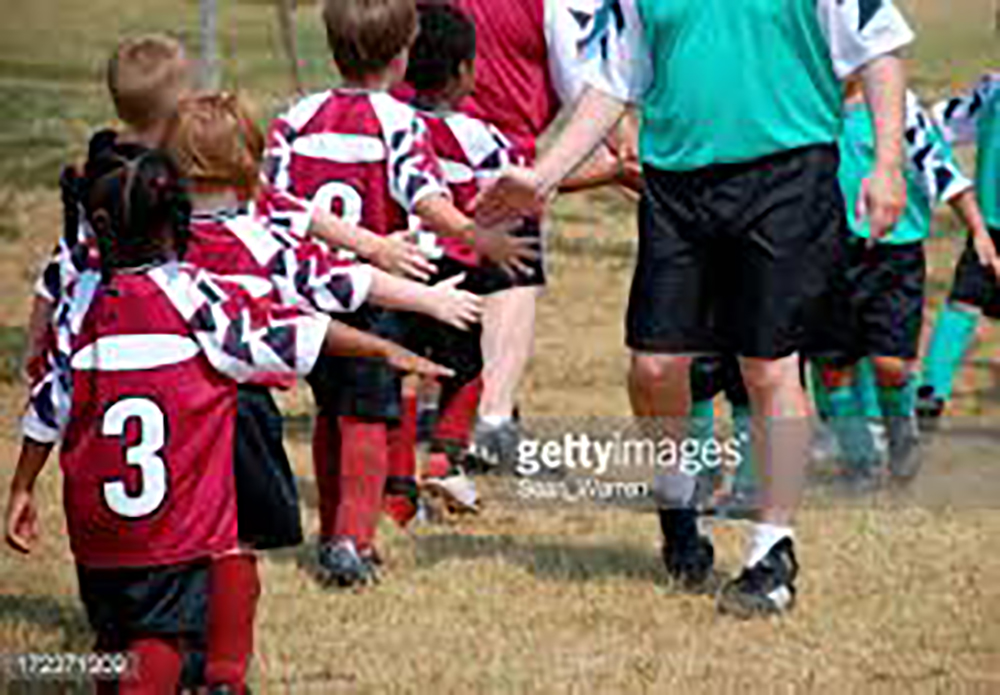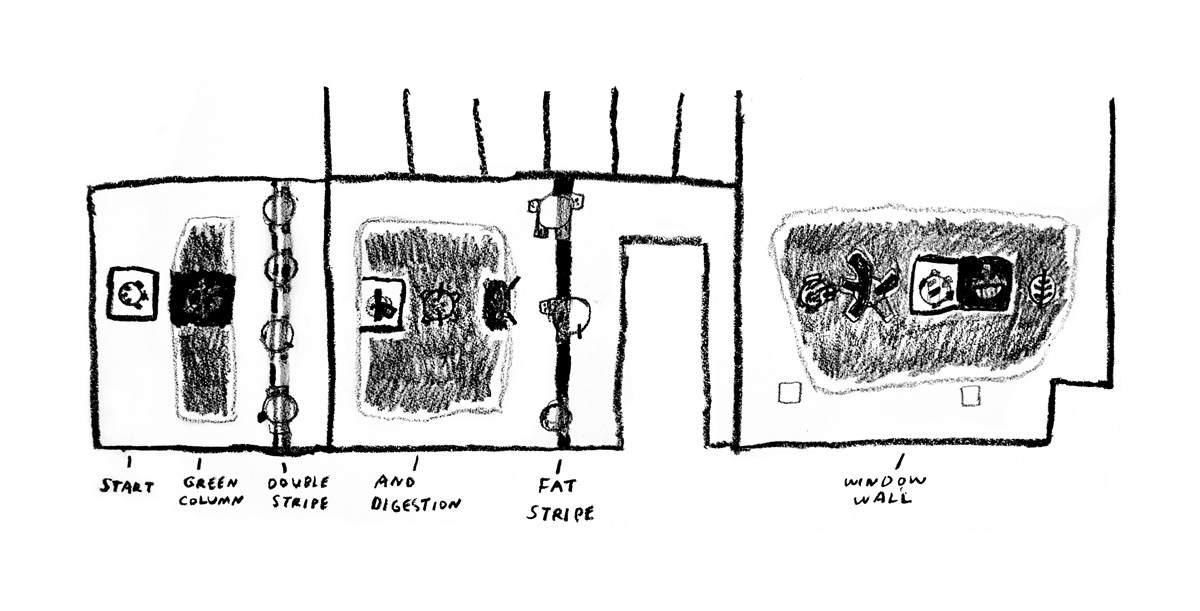
Maren Miller and Katya Tepper are long time friends who studied together at The Cooper Union. Maren co-runs The Hand Space. In the months preceding Katya’s exhibit b is for backwards b (d), they conducted a series of conversations about the work in the show.
Backwards
M: Do you have any further thoughts on what you think you want to call the show?
K: It’s leaning heavily toward: b is for backwards b (d)
M: What is the point of the (d) part? ‘Cause it just sounds really amazing?
K: [Laughing] Just in case you didn’t realize that’s what the backwards b is.
M: Yeah. That’s what I thought. [Laughing]
K: Obviously I’m saying too much. But I think that’s kind of funny to do, be really insistent about this idea. I’d rather say too much than too little.
I also like when you throw in the parentheses it starts to look like math. I’m thinking a lot about notation. And I love the idea of flipping something backwards as the most rudimentary way to change its meaning. Change the orientation, change the meaning. And letters are an easy way to demonstrate that. The visual of that mirror effect is important too, so that’s why I want that (d) in there.
Watching something on rewind or in reverse is an easy way to manipulate reality into suddenly looking fucked up and distorted. I just read this essay by Hilton Als about Flannery O’Connor and how as a young child she trained a chicken to walk backwards. That’s exactly the kind of strangeness I want there to be in the world that I’m making. A chicken walking backwards. It’s such a simple manipulation of the everyday and it’s so disturbing.
[M&K laughing]
M: That seems directly related to the sort of—and I want to use the word “dumb” in the way that it’s nonsensical—the “dumb” act of putting a bowl on the wall. Stripping it of its function.
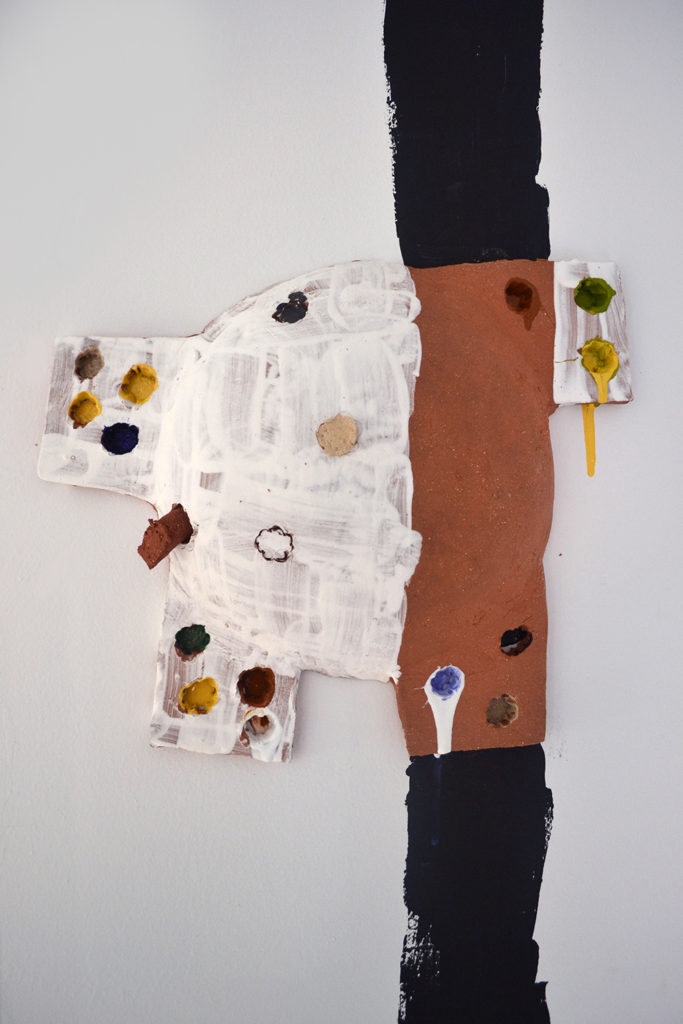
M: Let’s talk about why the bowls are on the wall.
K: I think that walls are the place I like to perform because of their relationship to decoration, display, mural, and flatness. Clay comes from the ground, so there’s also something backwards about taking it off the floor. You naturally understand—with things hung on the wall at eye level—that you can walk over and see it up close, and then walk away and see it from far away. At this scale they can’t be on the floor, and I can’t put them on pedestals because that’s insane.
[M&K laughing]
M: Yeah, I think we can all agree that’s insane.
K: I also want them to address the space they are in and react to it and shape it with paint. The way that they’re designed—there are rules that necessitate that paint goes through holes onto the wall. They marry the space that they’re in, and form a physical union with it. They’re not autonomous.
M: The holes in the sculptures initiate your reaction to them in an interesting, hyper-specific way. The back-and-forth between the object and the wall is inherent in the object itself.
K: Their hanging method is exposed and built into the silhouette and into the composition. An option for site specificity is built into their design and visual meaning. From there the wall painting—both in and out of the holes—can really take off. They feel totally naked until that happens.
M: It’s kind of like the inverse of site specificity. You create the specifics in the space.
K: I think it’s a pretty dominant gesture, actually. But I also think that it has the innocence of children drawing on the wall built into it.
M: It’s funny how your color palette is so restricted except for in the painted holes. You go wild in those holes. Throw in some blue and purple.
K: I like the idea that those become errant marks in this overall clean, graphic space. Some of the holes get painted a color that’s almost exactly the color of the clay, but it’s goopy drippy paint so it kind of distorts the weight of the material. The use of color in other dots draws attention to these really small painting moments.
Desperation
M: I’ve been thinking about what you said about notation, about language and math: does it have a relationship to mark-making? I’ve never been able to get as excited about mark-making as some people. But that makes me interested in understanding it, you know? It seems like a big part of “the mark” is the time element.
K: How long it takes to make a mark?
M: Or just the fact that a mark is a record of time.
K: I see mark-making as the first and most necessary part of a notation. A letter is a series of marks put together. So there’s something about stripping down that exercise to its most essential component. Stripping down the act of creating a notation, stripping that to just the process of trying. To say anything.
M: [Laughing]
K: There’s a desperation to making things, to wanting to share ideas, that compels me toward other art and to make art. There’s something tragic built into communication, and the mark is kind of the first moment of that. It’s related to a nonlinguistic utterance. I’m gonna try to communicate something and share it before it can signify anything other than the somewhat urgent act of trying to communicate something. Does that make sense?
M: Yeah, totally.
K: I try to make rules so that you can follow my steps. I painted this drippy pink inky line first, and you know that because then I painted the green and I painted around some of the pink drips. It’s not disembodied. There’s a residual performance of a person making decisions, cutting holes in the bowls and climbing ladders to mark up the wall. Like that great early Green Day song “I look into the past/I want to make it last/I was there/I was there.”
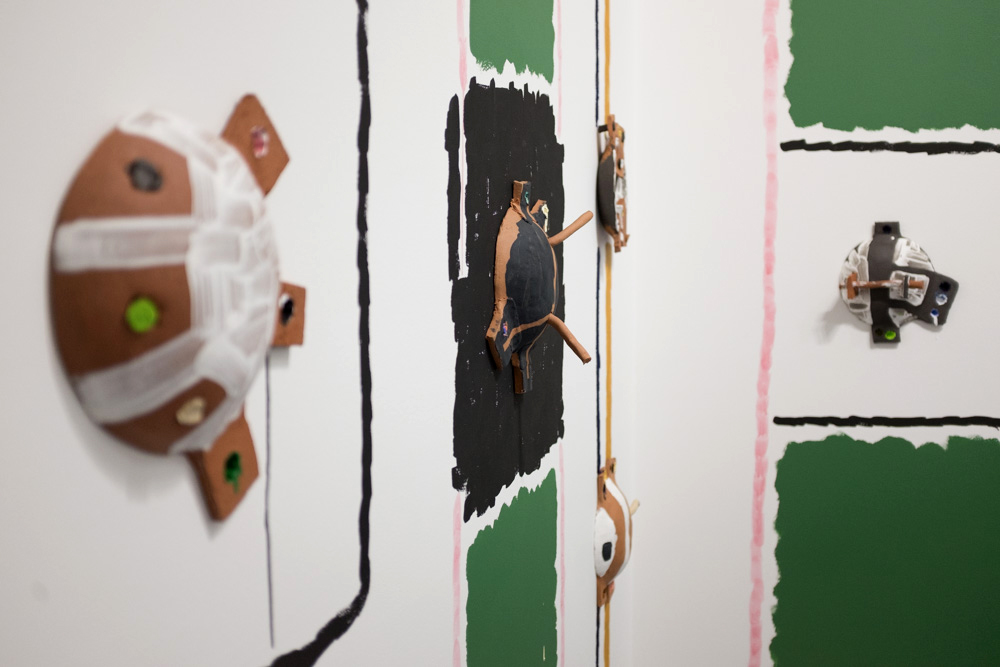
Aura
M: But if you didn’t call them Wall Bowls I wouldn’t think of them as bowls, necessarily.
K: They’re bowls on the wall, and at the same time they’re just circles that are, ya know, sculpted, rounded. They’re basic, geometric forms. They are hollow spheres cut in half. Then again, they are ceramic.
I’m working with one of the oldest materials manipulated by man. It’s heavily loaded. I came to clay because I wasn’t satisfied with the touch in my painting objects, and clay preserves touch in a really compelling way. Clay and paint don’t seem that different to me; you manipulate them when they’re soft and the finished product is hardened. They are both made from basic elements: oil, ground, fire. I was trying to treat clay like painting, trying to make it do whatever I wanted, and everything was breaking. And that’s something really nice about the material, you have to listen to it. It takes to being a vessel.
The bowl is a kind of primordial form that is so related to the body and the history of object making. The scale and form and its implied use have a relationship to the stomach and the hands and the face and mouth that I’m really drawn to. Its relationship to the body felt like a breakthrough.
M: It’s working with our primordial relationship with the form. The bowl is a shape so deeply embedded in our consciousness as a tool-making being that it acts as a baseline for your work. Everyone will relate on a certain level, and from there it can move forward.
K: Exactly. I think that I’m doing so many ridiculous and absurd things to them. I’ve started to treat the Wall Bowl as a completely neutral template that I can use to explore all of my other interests in composition and picture space. I really delight in that freedom. Because it always goes back to the body, it solves a lot of problems for me with content and subject matter. I always want the subject at hand to go back to the body. From the most abstract, formal, or architectural experiments—like the Stripe Bowls—to the ones that inhabit landscape or icon or other image space you’re familiar with, I want all those subjects to be portrayed in a really touched, bodily way.
M: You’re working with the vessel’s symbolic presence. Its archetypal purpose is part of the aura of the work.
K: Yeah, that’s a great way of talking about it. Aura. Can you ever take the bowl aura out of the bowl form? I want to make enough of them and present them in enough configurations that they waver in and out of being bowls on the wall and being just shapes in this large drawing. Hopefully, beyond the aura of the bowl there is just an automatic recognition of the belly and its negative space. Hopefully the body just knows.
●
M: Why are the bowls always the same size?
K: They’re not the exact same size, but they are all “bowl sized.” I relate to them as characters with different roles to serve in the script. They’re all the same species, and there’s a subtle range of sizes within that. Some require more surface area.
If they got too big or too small, they’d risk becoming exaggerated cartoons of bowls, and that’s not what I’m interested in. It would also be a really different project if the scale was truly standardized and I was casting them all from the same mold or something. Just to clarify, none of them are cast.
The size of the bowls has a lot to do with the size of hands making them. It’s one of those things where the scale has to “feel right.” I have two pretty clear modes for dealing with scale. The bowls embody an intimate scale, and the murals occupy space assertively. They’re kind of opposite bodily expressions. The bowls are made with the arms and hands pointed inward, and the murals are made with outstretched arms.

M: What do you think of the space behind the bowl?
K: A repeated gesture is the jamming of tootsie roll shaped clay into these punctured holes. I hope that the tension of that action is part of the viewer’s imagination of what the back is. They’ve been pretty heavily molested. Wall Bowl (Digestion/2) is cut in half revealing both sides of that penetration. Between that piece and the Inverted Bowls, where the inner cavity faces out, I hope I’m engaging that space and creating some markers to interpret the others.
That hollow cavity is so loaded. The negative space of what holds food is a belly as much as it’s a bowl! Which actually . . . Maren, now we’re starting to get to the meat. A large part of my visual language has to do with imagined and implied spaces inside the body. Which is why I think I love to shove these tootsie things into holes, because insertion and excretion deal with entrances to these strange negative spaces I’m fascinated by.
M: I was curious if we were going to talk about those tootsie roll shapes and how much they look like poop logs or penetrating dicks.
K: The tootsie shapes are meant to be anthropomorphic even when the wall bowls are dealing with other imagery. Like the green bowls. All the green bowls are about plants and landscapes, so they play with pictorial representation, but still maintain these corporeal gestures.
●
M: How much are you thinking about decay? About worms and snakes and the breaking down of a body? The actual forms that you are working with are incredibly dark.
K: And violent, yeah. That’s all there, it’s all intuitive. The title of the show, b is for backwards b (d) . . . besides all the backwards stuff we talked about, it’s also supposed to invite an association game. My instant associations are: body is for backwards body (death, disease), butt is for backwards butt (dick, diarrhea).
[M&K laughing]
I’m curious what your associations are. For me, four letters into the alphabet and death is looming. There’s a brutality that is just part of my world view. And I love when really dark subjects are portrayed with humor and joy.
Basics
M: There are some things you said you wanted to talk about that I’m a little confused about, specifically the “aesthetics of education.”
K: I’m thinking about kindergarten classrooms and children’s science museums. Environments that are set up to be unabashedly friendly and inviting and engaging. I feel pretty influenced by that method of display. I really love the use of simplified forms. The way that in kindergarten you get to play learning games with pieces of paper that are shaped like dogs but they’re solid yellow and then you have to put them in a yellow slot or something; that’s the kind of activity whose visual logic feels very poetic to me.
M: Yeah, yeah. So, let me just think for a second. I get the aesthetic sense of bold colors and simplified messages, but is it also related to a human being’s early development of language? And learning how to express potentially complicated concepts with really basic building blocks? So much of your work seems to have to do not only with language but also the inadequacy of language.
K: Well it’s true that I’m trying to tap into a really visceral, really felt understanding of things, but also deal with how to organize that into a language.
Wall Bowl (Conjunction) functions as language to me. I’m using the green wall paint to wrap individual units into one sentence, so to speak. This grouping features the two repeated Digestion bowls in different colors. Next to them I’m placing Conjunction Bowl, which shows two different colored tabs being connected by a third piece. It visually describes the grammatical function of a conjunction. Conjunction Bowl is in a white rectangle within a green rectangle/bubble/field containing all three wall bowls. In this case I’m using repetition explicitly and it’s important to me that it’s not a diptych. The whole piece is called And Digestion.
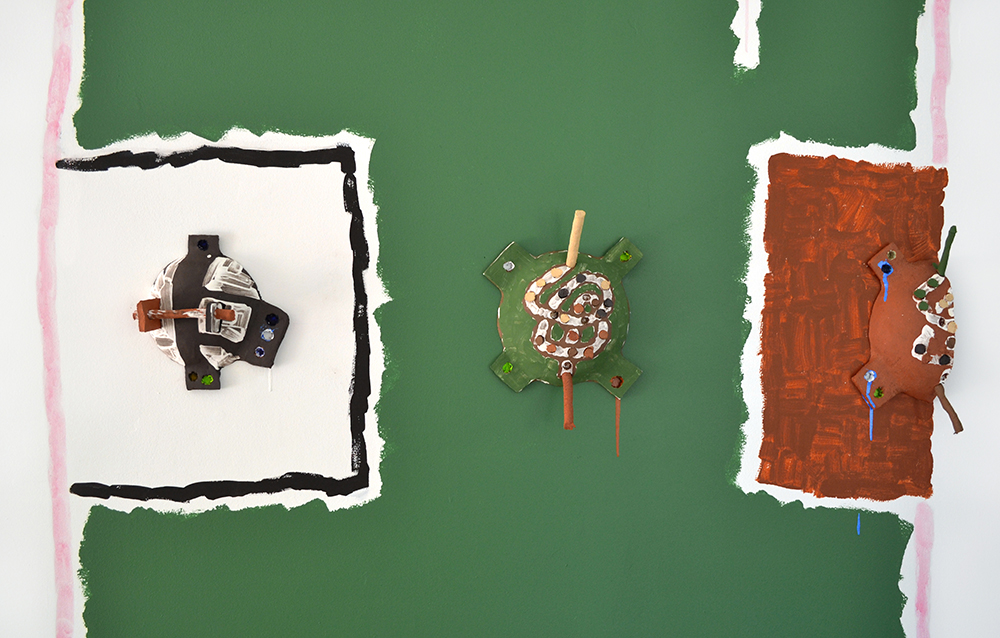
M: Do you think of the murals as mimicking the structure of a sentence?
K: Something between sentence and category. I want to use the colored murals to assign subject matter/themes to certain parts of the wall and break up the space into a weird syntax. The stripe bowls I think of as punctuation. Painting sections of the wall green to install these bowls is a really loud, really artificial allusion to nature. The brown section suggests poop and dirt, the black sections death and the void. The white is the opposite but equal void.
I’m trying to create a really absurd but also emotional equation with how I’m using color and composition to create groupings. It’s meant to be a language that you can enter into, but you’re not supposed to leave with anything concrete. Just a lot of impressions, including poop in your body, and leaves, and errant marks on the wall.
●
M: One of the things that I was putting down in my notes was it kind of has this sense of “how direct can you be without shutting down an interpretation?” Like, “green is nature, brown is dirt, brown is poop, and you can’t escape it.” It’s pressing really hard up against these really basic associations with color and shape that it’s kind of provoking the audience to wonder: Is this an intellectual exercise? Or is this an instinctual exercise?
K: Where does one end and the other begin? That’s the thing I’m most curious about. You’re talking about how automatic the associations become, how there’s an automation to recognizing certain forms. There’s an automation in creating them too. Ultimately they’re open to whatever interpretations are out there.
Penetration
M: I think that a lot of the power of the work comes from the crossed wires of intuitive decision making and intellectual decision making. Their back and forth. A lot of what you’re dealing with is consciousness and how we interpret the world.
I think that penetration is a big theme. Not just in terms of sex (that, too, though)—but also the body as a translator. And that can be really physical: from the movement of food out through your end, but also very much—
K: Ideas penetrating?
M: Yeah. The world and how we understand it. Where does the world end and the body begin. Do you think about that at all? This is a such strong metaphor for me because you’ve talked so much about the bowls reacting to the wall, and the wall reacting to the bowl again—this reverberation between the two.
K: Simultaneous penetration makes me think of memory. And that may be the same thing as consciousness. Processing an experience that’s already passed and then being confused through memory by what sensations were in the world and what sensations were in the body, and what sensations I’m adding to the memory in the present, and am I ever experiencing the present divorced from memory? Memory and association are basically the same thing. On a visual level, what I was saying about putting yellow paper dogs in yellow slots—let’s say that hypothetical yellow is the same color as a sunflower and it’s also the color of the car I almost died in. Put it all in the same yellow slot of my brain! Every time I see a bright happy sunflower, I’m feeling that car crash too.
●
M: There’s the immediacy of the tactile sensation of the clay and also the psychological sensation of being confronted by a giant green wall. I was hoping we could talk more about your relationship to green. Can we talk about the fact that this is green, and it’s green for nature?
K: I like all colors equally but I couldn’t live without green. I honestly get a physical sensation of feeling dehydrated when I don’t see enough green. And I’ve been making this work throughout the summer so I’ve been observing a lot of intense things happening in plants. You see a lot of death and brutality and decay and a lot of sexuality and hunger and domination. I get to witness all these cycles in plants and it puts other cycles into perspective.
I’m drawing parallels between our bodies and plants’ bodies. Take the Digestion Bowls: one is a green bowl on a green wall, so it’s not necessarily showing an animal digestive system. It kind of implies photosynthesis and the terracotta coming out the end could be the ground, it’s kind of a stem and roots. Whereas the one next to it is much more explicit. There’s green going into it, consuming a plant, and it comes out dark brown.
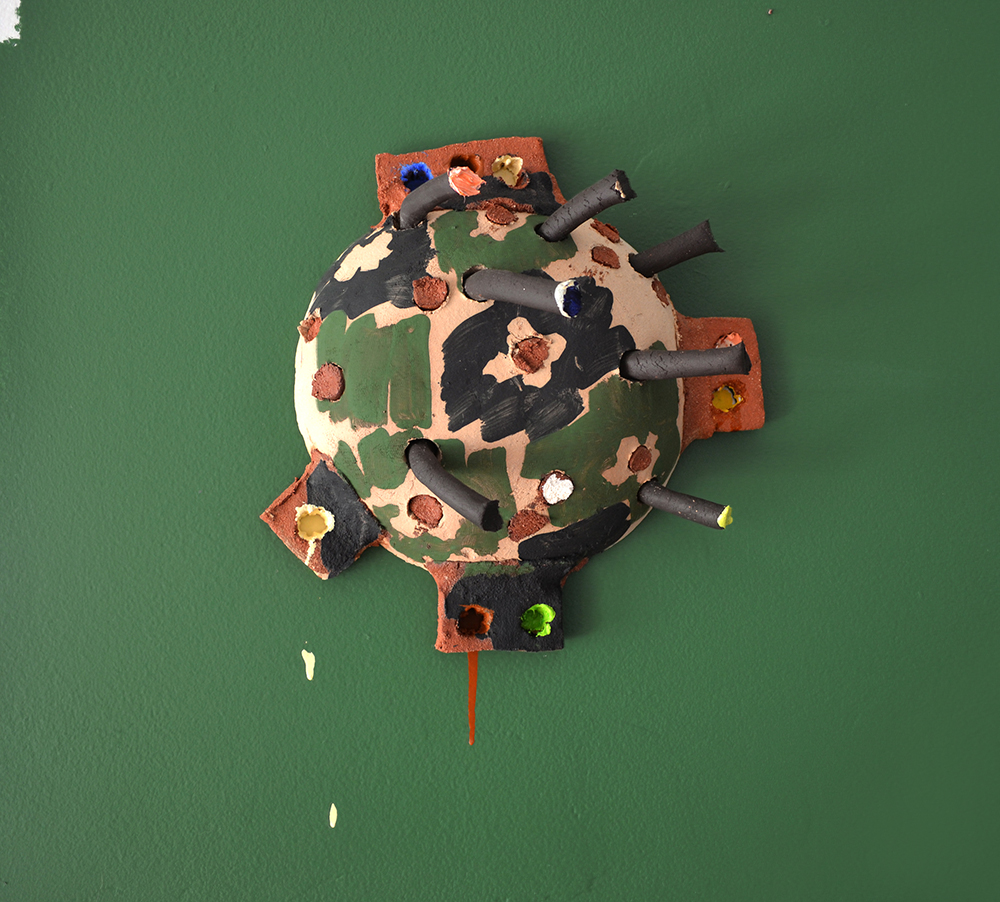
M: What about Wall Bowl (Stalker/Grandma’s Sheets)? That one sticks out as being especially different. Maybe it’s just the title.
K: That piece is translating plants into a decorative pattern. I was thinking about happy Flower Power patterns that were reminiscent of textiles from the seventies (aka my grandma’s sheets), but I was using this color scheme of green, black, and brown, so it’s totally camo also. I mean, I actually wrote something down about it . . . let me pull that up. . .
M: Yeah, yeah!
K: I think I wrote down like two words so don’t get too excited.
M: I’m getting very excited.
K: I want it to have the bubbliness of Flower Power with the violence of hunting and war.
M: That makes sense. I think they’re deeply linked. I mean, you are making a show that’s about nature.
K: Right. I love the Flower Power aesthetic, and I think I’m partially drawn to it because of the failure that is associated with it as a social movement. The bubbliness, the poppiness, the celebration of nature, the idealism—combined with how much the world didn’t change and the cynical world we inherited—that makes me really interested in how it’s just a decorative motif now. My next project is using this pattern all over the wall in red, yellow, and black with pink-themed bowls. I’m going to keep playing with making it look violent and think about it in a “girly” way.
Bathos
M: Let’s talk about some of the pieces that aren’t green.
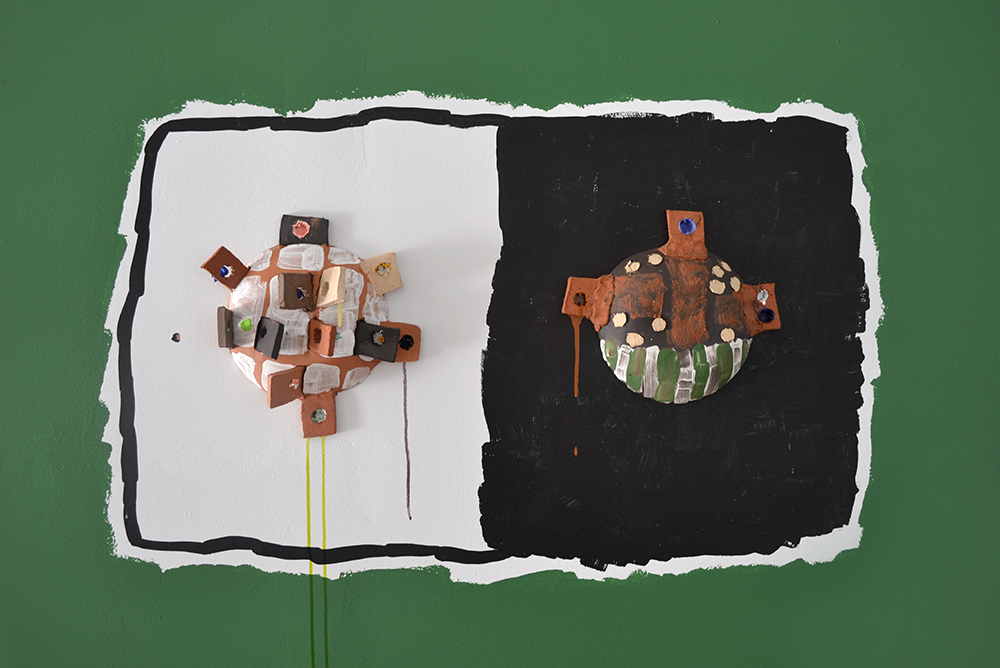
K: There’s Wall Bowl (Good Game), the one with all those tabs sticking out. It’s in the white part of the window shape in Window Wall, and Wall Bowl (Green Night) is in black. I think there’s an archetypal night/day reference. Also window. Also book. It feels kind of like a sun. It’s contributing to the narrative about natural cycles. But then it’s intended to do other things too.
Some of my titles are just to help me organize pieces, and some of them come out as puns. With Wall Bowl (Good Game), the title and form together evoke a board game. There’s also a game in how I’m painting it, through the holes onto the piece and onto the wall. Then there’s this thing in soccer where all the kids line up into two processions and really unenthusiastically slap hands as the lines cross each other, and the kids say “good game” like forty times on repeat. That’s a kind of ideal human behavior I like to see in the world. [Laughing] I think the tabs in Good Game, situated in this green and white field on the wall, look like those hands.
Then there are the Stripe Bowls, and then Wall Bowl (Black Stick) and Wall Bowl (Fake Twist). Those are all really formal.
M: What do you mean by formal?
K: They’re about negative space and creating a line or shape using negative space. Painting something by painting everything around it. I’m so moved by what you can say with paint and negative space. How you can honor something by honoring everything except that thing. I was trying to reduce that Vuillard way of painting to very simple compositions and application, and then play with the pieces referring back to themselves. Either the stripe continues onto the wall, or it becomes a tootsie penetrating out of the bowl, or the external tabs are fake mirrored in the bowl itself. That’s what I mean by formal.
M: …I’m trying to verbalize how I’m seeing these pieces relate to Good Game. The way you’ve abstracted a weird human ritual. I feel like you could describe that in the same way you’ve described these pieces.
K: The formal qualities of the procession of kids saying “good game”?
M: Yeah
K: Totally! It is formal by definition of formality. The moments in life when kids line up to slap hands and say “good game good game good game”: that becomes a poetic experience/ tradition/memory. It’s just so absurd, and it is incredibly formal like modern dance but also has this weird moral undertone. I definitely want to summon a glimpse of that without having to go ahead and re-create it.
M: Yeah. I mean, do you feel like you’re trying to draw some kind of tension between those absurdist distillations of cultural artifacts and our relationship to form? Is that an insane question?
K: Draw attention or create tension?
M: Create tension. I guess what I’m asking is: do you think these two things illuminate each other in some way?
K: Specify what you mean by these two things.
M: Art-form related shape and line, versus weird cultural or memory-based artifacts.
K: I’m trying to point at a bunch of different things at once and make them simultaneous in a single moment of recognition: the bowl, the classroom, games, traditions, plants, sex, violence, decomposition, etc. It’s all weird to me because it’s all so formal. Maybe I just take tension for granted because that’s the only thing I ever experience. [Laughing]
I would never make this sentence my art, but for the purpose of this conversation the sentence might read something like:
I was on the field, I was slapping children and saying good game, the field was green, the bowl is a game, the wall is green, the bowl is a sun, the leaf is pooping, the line isn’t there, or there or there, I’m dying.
[M&K laughing]
●
M: I feel that this work has an antagonistic relationship to “normal” thought processes. I think that in a lot of ways it’s antagonizing this idea that we can have intellectual conversations about certain things.
K: I think that goes back to sensation. You can move through the world intellectualizing all you want, but there is also a silent, passive absorption taking place, like the digestion of food and the metaphor you brought up earlier, the digestion of experience. Even within the established intellectual parameters of viewing art, a lot happens that is unconscious, and for me that’s the meat. I would like to set a stage for my work to be read with that in mind.
Did I send you this word bathos that I wanted to talk about?
M: You’re always talking about bathos, but I can’t remember what it is.
K: It’s the most perfect word that [our friend] Loren showed me ten years ago. I’ll just read the Webster definition: “(especially in a work of literature) an effect of anticlimax created by an unintentional lapse in mood from the sublime to the trivial or ridiculous.”
I can’t get over that word! It makes me very emotional.
M: It’s really great.
K: If I’m trying to create an effect, bathos sounds most accurate, even though it’s supposed to be unintentional. I wouldn’t say I’m consciously going out of my way to create the effect, more that I know it’s inevitable and I don’t fight it. Like death!
●
K: Good game.
M: Good game.
K: Good game.
